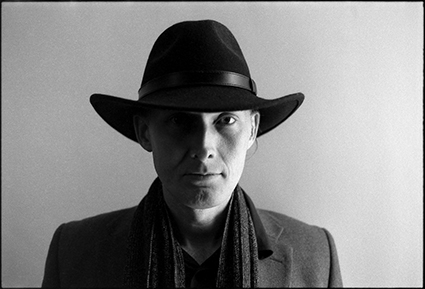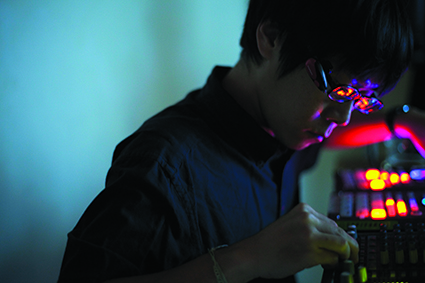The body as ear
Gail Priest: Lawrence English, Room40’s Open Frame, Carriageworks

Lawrence English
photo Marc Behrens
Lawrence English
For those vague on their history (like me), the original Room40 was both the office and the group of cryptologists established at Bletchley Park in England during World War I tasked with deciphering German command codes. By World War II the team, which included Alan Turing, the forefather of modern computing, cracked the legendary Enigma Code, which is said to have significantly shortened the war.
Room40 was the inspiration, and became the name, for Brisbane-based sound artist Lawrence English for the arts organisation he founded in 2000. He explains, “That facility brought together crossword puzzlers, military experts, scientists, philosophers, bakers—anyone who was interested in code breaking and applied them to the same set of tasks…a common interest.” For English this resonated with his mission to promote the work of a range of artists with diverse musical output yet sharing “a genuine depth of interest in the sonic capacity to transform us.”
Fifteen years later and the sound and experimental music landscape is significantly different in terms of its cultural profile, relationship to other musics and its distribution channels. English has survived by being responsive and adaptable—he was an early adopter of monetised digital downloads—growing the label to include niche sibling projects such as the avant-pop-focused Someone Good and cassette imprint A Guide To Saints. English suggests that the label’s longevity has been assisted by Australia’s tyranny of distance: “I’ve never felt like I have to run anyone else’s race. I just do what I believe in and that’s been really helpful.” He also suggests that this distance gives the label a certain ‘mythology’ within the international landscape.
But of course Room40 is more than a label and distribution point. From its initial inception the organisation has also produced and promoted events starting with Fabrique at the Brisbane Powerhouse in the early 2000s, to Syncretism at the Judith Wright Centre and Mono at IMA, which continues today. English has also been involved in major festivals, acting as the Brisbane director of various Liquid Architecture and What is Music? festivals as well as his own Open Frame event. After many Brisbane manifestations (with some 10th birthday celebrations in London), this year’s Open Frame will take place in Sydney in July at Carriageworks.
Spread over two nights, the festival offers an impressive line-up of Australian and international artists who’ve either been directly released by Room40 or whom English sees as “influential” not just musically but in the way they’ve developed the experimental music milieu. One such guest is William Basinski (US). “Apart from the fact that his music is very very particular and fascinating and beautiful…[Basinski’s] Arcadia Project from New York summarises for me a certain way of making things happen and a kind of community building.”
Improviser, producer and one time Sonic Youth member Jim O’Rourke is a similar order of statesman to Basinski. He no longer travels from his home in Japan but English has been communicating with him for several years to tee up a remote presence. The result will be a multichannel pre-recorded sound work that English will “diffuse” (spatialise) over an eight-speaker set up.

Makino Takashi
photo courtesy the artist
Makino Takashi
This year’s festival also incorporates a significant visual element. English is the first to be critical of unrigorous matching of visuals with sound suggesting that he is not interested in providing a distraction for audiences unaccustomed to simply watching an electronic artist’s minimal gestures: “I would rather listen to a really fantastic DJ play with nothing than an average DJ with some visuals.” However English believes that the artists he’s programmed use visuals in distinct and integrated ways. For example Makino Takashi from Japan creates both audio and visuals, the latter produced through a process that involves 16mm film that is digitally processed. For his Open Frame performance, Space Noise, he is working with a three-dimensional technique that differs from the standard red-blue offset method. “You really get that sense of pure psychedelia from what he does. I don’t know how it’s done to be perfectly frank, and I love it when I don’t know the magic trick.”
In fact all the visual elements are engaged with the physicality of film rather than just the manipulation of bits and bytes most often associated with electronic music. An interesting pairing of Australian artists is the much respected improvising pianist Chris Abrahams with filmmaker Louise Curham who uses hand-drawn film processes and manipulates the 16mm film live. This is a collaboration so intriguing and with so much potential it’s surprising it hasn’t happened before.
Also driven by 16mm film will be a collaboration between US filmmaker Paul Clipson and experimental pop artist Grouper (Liz Harris) presenting a long form piece, Hypnosis Display. Clipson’s methodology employs only in-camera edits. His mediation on the vast landscapes of contemporary America will be accompanied live by Harris.
Another collaboration English suggests has just been waiting to happen is between Robbie Avenaim with his SARPs project (Semi Automated Robotic Percussion System) and emerging composer Austin Buckett whose Grain Loops came out on vinyl via Room40 last year. Both artists are interrogating the very meaning of rhythm through quite different systems. English is hoping that their collaboration finds “not a middle ground. I’m hoping for a third ground—a third way.”
And finally, English himself will take the stage, something Sydney has not experienced for quite some time due to the curious lack of medium-sized venues interested in experimental music and able to facilitate a particular level of awesome subsonics. He explains, “What I’m interested in is this idea of the ‘body as the ear’ and a kind of synaesthetic turning point between touch and listening. To do that you need to have PA that can put out the right sound pressure.” If his performance at UnSound in Adelaide earlier this year is anything to go by, this will be unmissable (see RT126, p11).
After 15 years, does English see Room40 continuing indefinitely? “I have no interest in this idea that you can do, so you do. I’m really critical of what Room40 is about, but I think that criticality is a positive thing because it means it doesn’t become stagnant and one-dimensional, which anything can over time. I just want it to remain a little bit fugitive and restless because that’s what keeps it interesting for me and other people.”
See also Gail Priest’s 2014 profile on Lawrence English.
Room40: Open Frame, Carriageworks, 30-31 June
RealTime issue #127 June-July 2015 pg. 47






